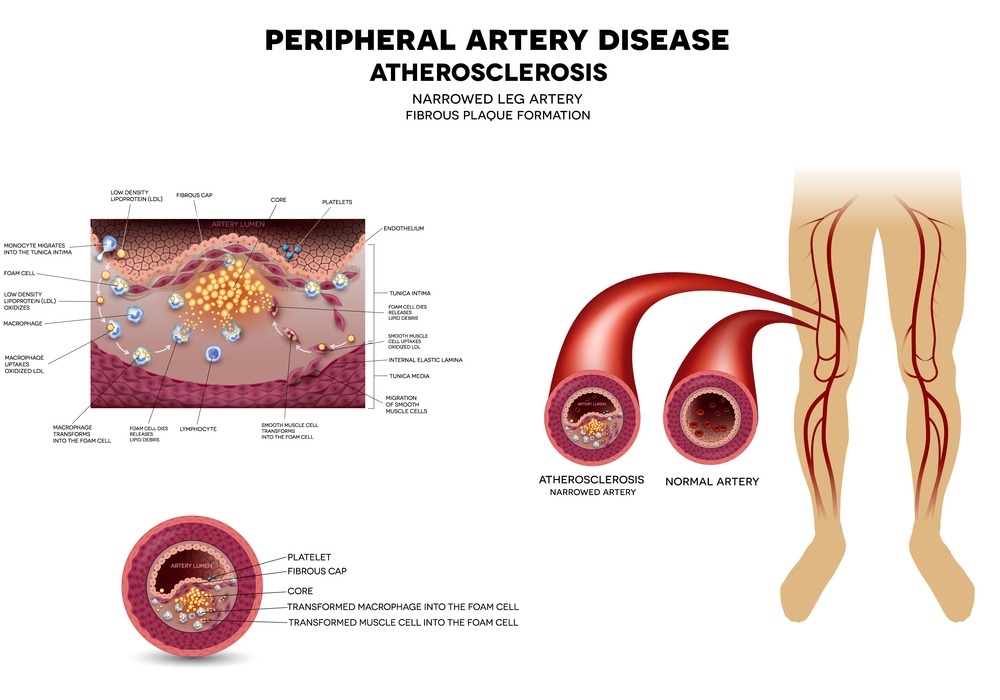PAD- What Causes It and How Can You Cure It? | VIR Colorado
By Erika Bynon - August 2, 2021
Peripheral Arterial Disease, or PAD, is serious chronic disease that occurs as a result of plaque build-up or narrowing arteries, typically in the legs and arms. Plaque build-up occurs due to atherosclerosis or hardening of the arteries from high cholesterol or scar build up over the years. PAD is a systemic disease, so people with atherosclerosis are at higher risk for heart disease and even stroke. Since PAD symptoms may overlap those of other diseases, your doctor may perform an ankle blood pressure measurement (Ankle-Brachial Index, ABI) or CT Angiogram to confirm the diagnosis. Oftentimes, exercise, maintaining a healthy diet and quitting tobacco in any form will help to reduce or even eliminate PAD. Other times, medical intervention is required.
PAD is relatively common. Society for Vascular Surgery estimates that more than 10 million people in the U.S. suffer from PAD and Center for Disease Control estimates that 12-20% of individuals older than 60 have PAD in the U.S
.
Essentially, when a person develops PAD, their limbs are not receiving enough blood flow to keep up with demand.
As a result, people may see or experience a variety of symptoms:
Go Back PAD is relatively common. Society for Vascular Surgery estimates that more than 10 million people in the U.S. suffer from PAD and Center for Disease Control estimates that 12-20% of individuals older than 60 have PAD in the U.S
.
Essentially, when a person develops PAD, their limbs are not receiving enough blood flow to keep up with demand.
As a result, people may see or experience a variety of symptoms:
- Claudication- cramping of the legs during activity
- Numbness, tingling or weakness in lower extremities
- Burning or pain in lower extremities when at rest
- Non-healing leg or foot sores
- Slower growth of your toenails
- No pulse or weak pulse in your legs or feet
- Coldness or changes in skin color of legs or feet
- Muscle deterioration, loss of hair or smooth, shiny skin on legs
- Erectile dysfunction in men
- Smoking
- High blood pressure
- Diabetes
- Atherosclerosis
- High cholesterol/triglycerides
- Kidney failure
- Obesity/physical inactivity
- Family history of heart disease
- Age > 60
- Angioplasty and Stenting
- This effective, minimally invasive, outpatient procedure uses a catheter, or balloon, to effectively treat blockages in arteries by enlarging or stretching the artery to allow blood to flow more easily. Once the balloon is removed, a stent or small metal sleeve may be placed in the artery to keep it open.
- Endarterectomy
- When stents are not an option, this surgical procedure can help to remove plaque from your artery to restore blood flow. Recovery typically takes just a week or two.
- Bypass Surgery
- If angioplasty or an endarterectomy is not an option, bypass surgery may be required. This open surgery uses a vein or synthetic tube to essentially create a detour around a severely narrowed or blocked artery in order to restore blood flow. Although this requires a longer hospital stay and recovery, it is the most durable long-term remedy.
- Critical Limb Ischemia:
- Often starting as wounds or sores that won’t heal, an injury or infection, it can progress to the death of tissue and possibly even amputation.
- Stroke and Heart Attack:
- Sometimes the narrowing or blockage of arteries isn’t limited to just your lower extremities. It may also affect your arteries supplying blood to your heart and brain.
